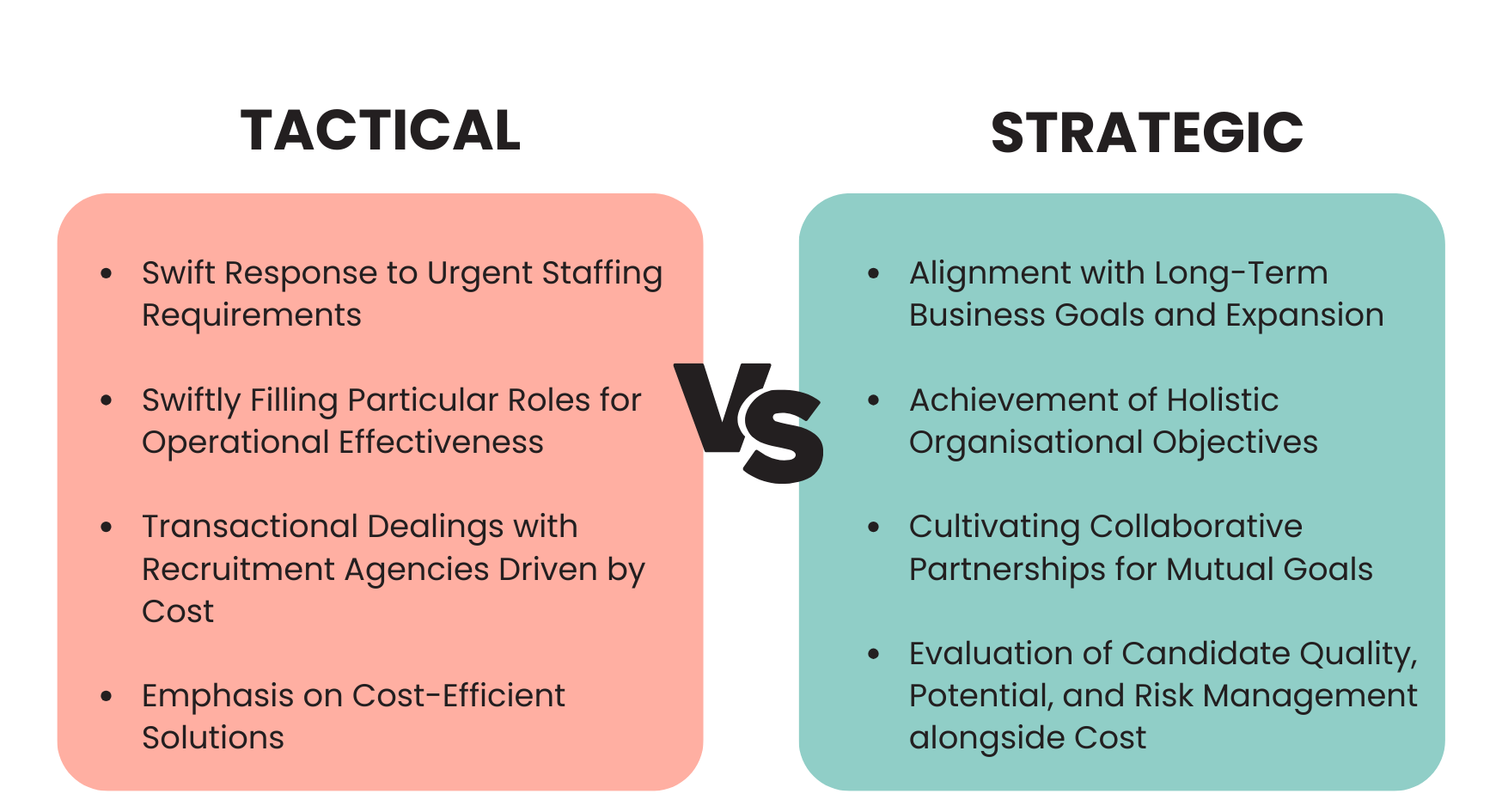< Back to all blogs
Distinguishing Between Tactical and Strategic Sourcing: An In-Depth Examination

Wed, 20 Sep, 2023
In an ever-evolving world of business, sourcing is a crucial cornerstone in the talent acquisition process. As companies strive to attract and keep the best talent, the tactics employed can make a huge difference. Tactical and strategic sourcing – two different methodologies that have a considerable impact in the recruitment sector. This deep dive aims to illustrate the subtle differences that separate these methods, providing a thorough understanding of when, why, and how companies might select between them, ultimately shaping the course of their recruitment success.
Tactical Sourcing: Breaking It Down
Tactical sourcing represents a fluid approach centred on meeting immediate staffing requirements promptly. It involves the strategic procurement of qualified individuals to address current talent voids within an enterprise.
The primary goal of tactical sourcing is dual-pronged: cost-effective hiring and streamlined recruitment operations.
Companies utilising tactical sourcing techniques prioritise speedy results, aiming to rapidly identify, engage, and integrate individuals who can contribute quickly to the company’s objectives.
For instance, a technology startup witnessing sudden project expansion may opt for tactical sourcing to swiftly secure skilled developers for an upcoming software release. Similarly, a retail chain seeking seasonal staff to cater to increased holiday demand utilises tactical sourcing to efficiently increase its workforce. These instances underscore how tactical sourcing in recruitment promptly addresses urgent staffing requirements while maintaining a focus on optimising recruitment expenses.
Strategic Sourcing: A Closer Look
Strategic sourcing encapsulates a holistic and future-focused methodology that transcends immediate hiring needs. It involves an all-encompassing approach to talent acquisition, intricately aligned with a company’s overall business strategy.
At the heart of strategic sourcing in recruitment is the nurturing of strong, mutually advantageous relationships with talent suppliers, which might encompass staffing agencies, professional networks, and educational establishments.
Unlike tactical sourcing, where cost is the main focus, strategic sourcing gives equal weight to aspects such as candidate quality, long-term potential, and innovative capabilities. For instance, a multinational company seeking to establish itself as a sector leader might engage in strategic sourcing by forging partnerships with top universities to tap into emerging talent. Similarly, a healthcare institution aiming to provide advanced patient care might strategically source specialised medical professionals with unique skill sets.
Contrasting Tactical and Strategic Sourcing
Tactical and strategic sourcing diverge significantly, shaping the landscape of talent acquisition.
Let’s examine these differences:

1. Time Horizon: Immediate vs. Forward-Looking
- Tactical Sourcing provides a swift response to immediate staffing needs.
- Strategic Sourcing aligns with long-term business aspirations and growth.
2. Scope: Operational Efficacy vs. Overall Business Aims
- Tactical Sourcing concentrates on promptly filling specific roles for operational efficacy.
- Strategic Sourcing encompasses a broader view, contributing to the achievement of overall organisational goals.
3. Recruiter Relationships: Transactional vs. Collaborative
- Tactical Sourcing involves transactional interactions with recruitment agencies based on cost.
- Strategic Sourcing cultivates collaborative partnerships for shared objectives.
4. Considerations: Expense vs. Quality, Innovation, and Risk Management
- Tactical Sourcing places emphasis on cost-effective solutions.
- Strategic Sourcing takes into account candidate quality, innovation potential, and risk management in addition to cost.
Striking a Balance: Merging Tactical and Strategic Sourcing
Champion the Synergy
Understanding how both methods can complement each other in the dynamic practice of recruitment, the symbiotic relationship between tactical and strategic sourcing becomes evident.
Tactical sourcing efficiently handles immediate needs, swiftly securing candidates with transactional precision. Meanwhile, strategic sourcing takes a long view, aligning with organisational goals to build a robust talent pipeline. By recognising the intrinsic balance between these methodologies, recruiters can leverage their combined power to enhance the overall recruitment process in your company.
Formulating a Hybrid Sourcing Strategy
The evolution of recruitment practices calls for an innovative approach – a hybrid sourcing strategy. This dynamic fusion captures the agility of tactical sourcing while embracing the foresight of strategic sourcing. Through this innovative blend, recruiters can swiftly address short-term talent gaps without losing sight of long-term talent acquisition objectives. The result is a flexible and responsive recruitment framework that adapts to the changing landscape of talent acquisition.
Realising Success Through Examples
The success of integrating tactical and strategic sourcing is vividly illustrated through real-world case studies. These accounts demonstrate how companies have harnessed the synergy between these sourcing methodologies to achieve remarkable recruitment outcomes. From swiftly filling critical positions to cultivating a future-ready workforce, these instances spotlight the transformative potential of a harmonised approach. By delving into these cases, recruiters can draw inspiration and insights to orchestrate their own seamless integration journey.
The convergence of tactical and strategic sourcing emerges as a compelling strategy. By embracing their interdependence, creating innovative hybrids, and drawing wisdom from exemplars, recruiters can master the art of balanced and effective talent acquisition.
- Embrace Cutting-Edge Technology: Adopt AI-powered tools, machine learning algorithms, and automation platforms to streamline candidate sourcing. These technologies can help identify and engage with potential candidates more efficiently, saving time and resources.
- Utilise Data-Driven Insights: Harness data analytics to gain insights into the effectiveness of your sourcing strategies. Analyse metrics such as source of hire, time-to-fill, and cost-per-hire to optimise your approach and make informed decisions.
- Adopt a Candidate-Centric Approach: Focus on creating personalised and meaningful interactions with candidates. Customise your outreach to address their specific needs, skills, and aspirations, enhancing the candidate experience and improving your chances of attracting top talent.
- Discover Innovative Sourcing Channels: Explore new and innovative sourcing channels beyond traditional job boards. Consider platforms like social media, industry-specific forums, virtual career fairs, and networking events to tap into a diverse pool of candidates. Read about using GitHub as a sourcing tool.
- Engage Passive Candidates: Engage with passive candidates who may not be actively looking for new opportunities but possess valuable skills. Build relationships over time by sharing industry insights, thought leadership, and relevant content.
- Promote Diversity and Inclusion: Prioritise diversity and inclusion in your sourcing efforts. Actively seek out candidates from underrepresented backgrounds to create a more inclusive workforce that brings diverse perspectives to your organisation.
- Foster Employer Branding: Cultivate a strong employer brand to attract candidates who resonate with your company culture and values. Highlight employee testimonials, company achievements, and unique benefits to differentiate your organisation from competitors.
- Collaborate with Hiring Managers: Foster close collaboration between recruiters and hiring managers. Regularly communicate to ensure alignment on job requirements, candidate profiles, and feedback, resulting in more accurate and efficient sourcing.
- Continuous Learning: Stay updated on the latest sourcing trends and techniques through workshops, webinars, conferences, and online resources. Adapting to the ever-changing recruitment landscape is crucial for sustained success.
- Agility and Flexibility: Remain adaptable to market shifts and changing candidate preferences. Adjust your sourcing strategies as needed to ensure they remain effective in different economic and social contexts.
- Ethical Sourcing: Practice ethical sourcing by respecting candidate privacy, providing transparent communication, and ensuring fair treatment throughout the recruitment process.
- Global Sourcing: Embrace the opportunity to source talent from a global pool. Remote work and virtual collaboration have made it easier to tap into talent from different geographic locations.
By incorporating these best practices into your sourcing strategy, you can enhance your ability to attract, engage, and hire top-quality candidates in the dynamic and competitive landscape of 2023.
Ready to optimise your recruitment sourcing strategy? Discover the power of tactical and strategic sourcing approaches and how they can elevate your talent acquisition game. Work with Fulcrum to discover the insights and expertise you need to navigate the dynamic landscape of tactical and strategic sourcing. Contact us today and let’s embark on a journey to source, engage, and hire the best candidates for your company’s success.
Continue reading
Turnover: Understanding the Impact
Turnover is a natural part of any business. Employees come and go for various reasons, and…
Choosing the Right Recruitment Approach: In-house, Agency, or Embedded?
Are you struggling to optimise your resources and find the right talent for your organisation? You’re…
Read More Choosing the Right Recruitment Approach: In-house, Agency, or Embedded?
Top Metrics for Understanding Employee Satisfaction
Employee satisfaction is a crucial indicator of an organisation’s success. Satisfied employees are more engaged, productive,…
Read More Top Metrics for Understanding Employee Satisfaction



